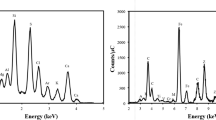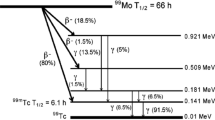Abstract
This method is based upon the measurement of 3.95-hr43Sc which is formed during α-activation from40Ca, the most abundant (96.8%) isotope of calcium. The excitation function for the40Ca(α, p)43Sc reaction was determined and the maximum yield of43Sc (about 107 cpm per mg of calcium for a 1-hr irradiation at a beam current of 1 μA) was obtained at an irradiation energy of 14 MeV. The interference free sensitivity of the method at this energy was found to be 8.5·10−12 g, for a 1-hr irradiation at a beam current of 10 μA. The elements most likely to interfere with the determination are potassium and scandium. The extent of this interference was investigated as a function of irradiation energy and methods to eliminate or subtract the activity formed from these elements are discussed. An attempt was made to determine non-destructively the calcium content of very pure silicon and aluminium and upper limits for the concentration of calcium in these samples were set at 0.27 ppb and 6.9 ppb, respectively. Magnesium, thulium oxide and yttrium oxide samples of known calcium content were also analysed.
Similar content being viewed by others

References
G. J. Atchison, W. H. Beamer,Anal. Chem., 24 (1952) 1812.
J. T. Corless,Anal. Chem., 38 (1966) 810.
E. Junod, J. Laverlochère, Proc. 3rd Intern. Coll. on Biology, Saclay, 1963.
F. W. E., Strelow, H. Staerk,Anal. Chem., 38 (1963) 1154.
M. Peisach, R. Pretorius Anal. Chem., 38 (1966) 956.
W. R. McMurray, M. Peisach, R. Pretorius, P. van der Merwe, I. J. van Heerden,Anal. Chem. 40 (1968) 266.
T. J. de Waal, M. Peisach, R. Pretorius,Anal. Chem., 41 (1969) 416.
F. Everling, L. A. Koenig, J. H. E. Mattauch, A. H. Wapstra, Nuclear Data Tables, Part I, Natl. Acad. Sci., Washington, 1961.
C. F. Williamson, J. P. Boujot, J. Picard, Rapport CEA-R3042, Saclay, 1966.
J. N. Barrandon, J. L. Debrun, Ph. Albert, Proc. 2nd Conf. on Practical Aspects of Activation Analysis with Charged Particles, EUR-3896, d.f.e., 1968, p. 277.
H. L. Rook, E. A. Schweikert,Anal. Chem., 41 (1969) 958.
J. B. Cumming, BNL-6470, NAS-NS 3170, Proc. Symp. Gatlinburg, Tennessee, USA, Oct. 1962.
H. P. Yule,Nucl. Phys. A94 (1967) 442.
C. Riley, K. Ueno, B. Linder,Phys. Rev., 135 (1964) B1340.
K. L. Chen, J. M. Miller,Phys. Rev., 134 (1964) B1269.
E. A. Ricci, R. L. Hahn,Anal. Chem., 37 (1965) 742.
H. L. Rook, E. A. Schweikert, R. E. Wainerdi,Anal. Chem., 40 (1968) 1194.
E. A. Schweikert, H. P. Yule, to be submitted toRadiochem. Radioanal. Letters.
G. H. Morrison, Trace Analysis, Physical Methods, Wiley and Sons, New York, 1966, p. 10.
Author information
Authors and Affiliations
Rights and permissions
About this article
Cite this article
Pretorius, R., Schweikert, E.A. Alpha activation of calcium and its possible use for analysis. J. Radioanal. Chem. 7, 319–327 (1971). https://doi.org/10.1007/BF02513803
Received:
Issue Date:
DOI: https://doi.org/10.1007/BF02513803



